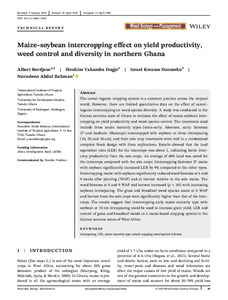| dc.contributor.author | Berdjour, A. |
| dc.contributor.author | Dugje, I.Y. |
| dc.contributor.author | Dzomeku, I.K. |
| dc.contributor.author | Rahman, N.A. |
| dc.date.accessioned | 2022-08-16T09:38:04Z |
| dc.date.available | 2022-08-16T09:38:04Z |
| dc.date.issued | 2020-06-29 |
| dc.identifier.citation | Berdjour, A., Dugje, I.Y., Dzomeku, I.K. & Rahman, N.A. (2020). Maize–soybean intercropping effect on yield productivity, weed control and diversity in northern Ghana. Weed Biology and Management, 20(2), 69-81. |
| dc.identifier.issn | 1444-6162 |
| dc.identifier.uri | https://hdl.handle.net/20.500.12478/7647 |
| dc.description.abstract | The cereal–legume cropping system is a common practice across the tropical world. However, there are limited quantitative data on the effect of cereal–legume intercropping on weed species diversity. A study was conducted in the Guinea savanna zone of Ghana to evaluate the effect of maize–soybean intercropping on yield productivity and weed species control. The treatments used include three maize maturity types (extra‐early: Abontem, early: Sammaz 27 and medium: Obatanpa) intercropped with soybean at three intraspacing (10, 20 and 30 cm), and their sole crop treatments were laid in a randomized complete block design with three replications. Results showed that the land equivalent ratio (LER) for the intercrops was above 1, indicating better intercrop productivity than the sole crops. An average of 40% land was saved for the intercrops compared with the sole crops. Intercropping Sammaz 27 maize with soybean significantly increased LER by 9% compared to the other types. Intercropping maize with soybean significantly reduced weed biomass at 6 and 9 weeks after planting (WAP) and at harvest relative to the sole maize. The weed biomass at 6 and 9 WAP and harvest increased (p < .05) with increasing soybean intraspacing. The grass and broadleaf weed species count at 6 WAP and harvest from the sole crops were significantly higher than that of the intercrops. The results suggest that intercropping early maize maturity type with soybean at 10 cm intraspacing could be used to increase grain yield, LER and control of grass and broadleaf weeds in a maize‐based cropping system in the Guinea savanna zones of West Africa. |
| dc.description.sponsorship | African Development Bank |
| dc.format.extent | 69-81 |
| dc.language.iso | en |
| dc.subject | Land Equivalent Ratio |
| dc.subject | Maize |
| dc.subject | Maturity |
| dc.subject | Mixed Cropping |
| dc.subject | Weeds |
| dc.subject | Soybeans |
| dc.subject | Weeds |
| dc.subject | Weed Control |
| dc.subject | Ghana |
| dc.title | Maize–soybean intercropping effect on yield productivity, weed control and diversity in northern Ghana |
| dc.type | Journal Article |
| cg.contributor.affiliation | International Institute of Tropical Agriculture |
| cg.contributor.affiliation | University for Development Studies, Ghana |
| cg.contributor.affiliation | University of Maiduguri |
| cg.coverage.region | Africa |
| cg.coverage.region | West Africa |
| cg.coverage.country | Ghana |
| cg.coverage.hub | Headquarters and Western Africa Hub |
| cg.identifier.bibtexciteid | BERDJOUR:2020 |
| cg.isijournal | ISI Journal |
| cg.authorship.types | CGIAR and developing country institute |
| cg.iitasubject | Agronomy |
| cg.iitasubject | Crop Systems |
| cg.iitasubject | Maize |
| cg.iitasubject | Plant Breeding |
| cg.iitasubject | Plant Production |
| cg.iitasubject | Soybean |
| cg.iitasubject | Weeds |
| cg.journal | Weed Biology and Management |
| cg.notes | Published online: 29 Jun 2020 |
| cg.accessibilitystatus | Limited Access |
| cg.reviewstatus | Peer Review |
| cg.usagerightslicense | Copyrighted; all rights reserved |
| cg.targetaudience | Scientists |
| cg.identifier.doi | https://dx.doi.org/10.1111/wbm.12198 |
| cg.iitaauthor.identifier | Ibrahim Dugje: 0000-0002-7672-1205 |
| cg.iitaauthor.identifier | Nurudeen Abdul Rahman: 0000-0003-4073-5610 |
| cg.futureupdate.required | No |
| cg.identifier.issue | 2 |
| cg.identifier.volume | 20 |

